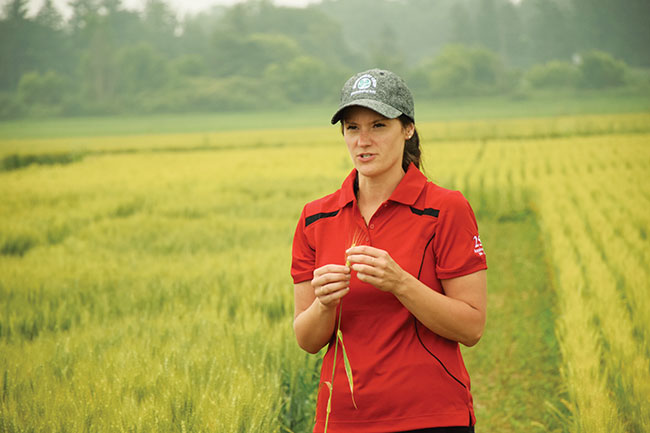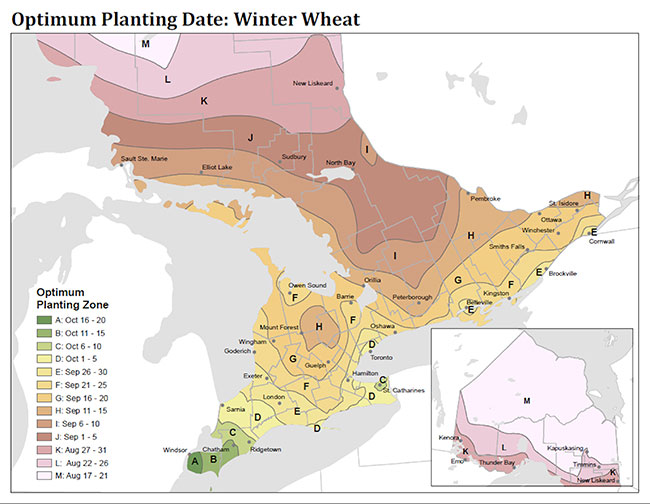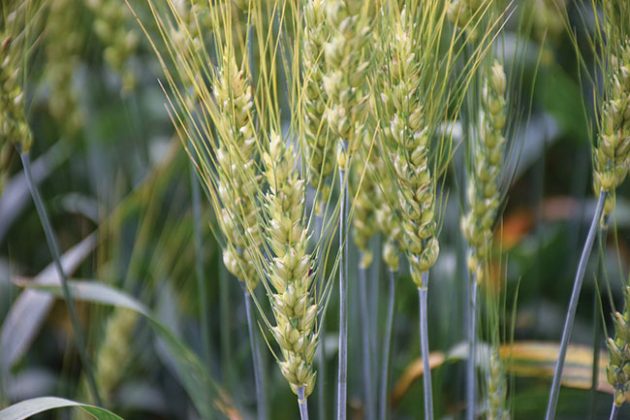
Features
Cereals
Seeding/Planting
Taking fall planting conditions in stride for winter wheat
A fresh look at planting dates and other tips for winter wheat seeding.
November 4, 2019 By Carolyn King
 Joanna Follings says planting early increases the risk of snow mould, lodging, take-all and barley yellow dwarf virus. PHOTO BY TOP CROP MANAGER.
Joanna Follings says planting early increases the risk of snow mould, lodging, take-all and barley yellow dwarf virus. PHOTO BY TOP CROP MANAGER. Ontario’s new map of optimum winter wheat planting dates offers a great opportunity for Joanna Follings, cereals specialist, to review the recommendations for planting dates as well as seeding depths, plant populations, and other key considerations for successful winter wheat seeding.
Early, late or on time
The new planting date map, released early in 2019, is an updated guide to help winter wheat growers across the province in making planting date decisions. The map was created using a formula developed by Andy Bootsma with Agriculture and Agri-Food Canada. It is based on more recent Ontario field trial and climate data than the old map.
“The new map is more detailed than the old one,” notes Follings, who is with the Ontario Ministry of Agriculture, Food and Rural Affairs (OMAFRA). “So producers are able to more accurately determine their planting date range. For example, the optimum planting date for Chatham-Kent and Essex on the old map was Oct. 10 or later. The new map breaks that area up into three zones with the ranges: Oct. 6 to 10, Oct. 11 to 15, and Oct. 16 to 20.”
Planting winter wheat outside of your optimum date range will increase the chance of yield reductions. The specific risks differ depending on whether you are planting very early or very late. Follings reviews the risks and explains how to minimize those risks.
“Some growers, especially if they have unseeded acres where they weren’t able to plant a corn or soybean crop this year [because of the poor spring weather], might want to start planting their winter wheat very early on those acres to make sure they get all their wheat planted. Generally speaking, we recommend planting no earlier than 10 to 14 days prior to your optimum planting date,” she says.
“With planting early, we tend to see an increased risk of snow mould, lodging, barley yellow dwarf virus, as well as take-all. So if you are going to plant more than 10 days prior to your optimum date, then be sure to drop your seeding rates by about 25 per cent. That will help mitigate some of the risks from early planting.”
With late planting, the main risk is not getting enough growing degree days to enable the wheat to get properly established before the snow flies. “It takes 80 growing degree days for wheat seed to germinate and another 50 growing degree days for the wheat to emerge, for every inch of seeding depth. So if you are planting at a depth of an inch, it takes 130 growing degree days in total for the crop to germinate and emerge,” Follings explains.
“If the weather is cool and the forecast predicts falling temperatures, then you probably won’t get the heat needed. So the seed will not be able to get out of the ground and tiller and get a good root system developed before winter.”
There’s no specific date that is always too late for successful winter wheat seeding. “Growers need to really pay attention to the temperature and the weather forecast to help decide when it is too late to plant.”
She recommends, “If you are planting after your optimum date, then increase your seeding rate by 200,000 seeds per week. That will help with the fact that there will likely be reduced tillering before winter.”

The new map for optimum planting dates for winter wheat was developed in partnership wih Weather Innovations Consulting LP. PHOTO COURTESY OF OMAFRA.
Tips for timely planting
For the many Ontario growers who plant winter wheat after soybean, Follings has some suggestions to help get wheat planted before the weather turns too chilly.
“Of course, we can’t completely control when soybeans are going to be harvested, but we can control our preparedness. So my suggestion would be to get your seeding equipment out of the shed and ensure it is in good working order and calibrated, and to make sure you have your seed and fertilizer ready to go. Then when your soybeans are coming off, you will be ready to follow the combine with the drill and get the wheat planted as soon as possible,” she says. “You also want to make sure that you are spreading all the soybean residue evenly as the soybeans are coming off.”
She also notes, “If you are not going to be planting winter wheat in all of your soybean fields, then I suggest that, if possible, you first harvest the fields intended for wheat. And if you have some earlier maturing crops, such as edible beans or canola, perhaps you could target those fields for winter wheat.”
What if it’s too late for winter wheat?
“If you aren’t able to get your winter wheat planted, then spring cereals are another great crop option especially if you are trying to keep a cereal in your rotation. [For instance,] a spring cereal could work well for livestock producers if they can’t get their winter wheat planted,” Follings says.
Frost seeding your spring cereal could be a good choice if you get the right weather conditions. In frost seeding, you plant very early in the spring after the snow has melted but when the soil has a light frost to support the tractor.
She notes, “Frost-seeded spring cereals have been shown to do quite well in Ontario. That’s because, the earlier you plant spring cereals, the more likely you are to miss the hot weather that often comes during pollination. So you can get pretty good yields with frost seeding.”
Other planting tips
“We generally recommend that cereals be planted at a depth of one inch. I know it can be challenging for producers to achieve that depth with some of the drills out there. But you need to avoid planting too shallow because that will increase your risk of winterkill and lower wheat yields. So, if you need to target a depth of 1.25 to 1.5 inches to get that one-inch depth, then do that,” Follings says.
To achieve the recommended plant populations, she says, “We advise targeting 1.4 to 1.8 million seeds per acre when you are seeding winter wheat at the optimum date. And as I said, drop your rate if you are seeding earlier and bump up your rate if you are seeding later.”
Starter fertilizer is also important. She notes, “Ontario research has shown that for both the sufficiency approach and the build-and-maintain approach to fertilizer applications, utilizing a phosphorus-containing starter fertilizer increases yields through the promotion of root development and uniform emergence. So consider applying a starter fertilizer based on your soil test.”
As well, she says if early-season seedling diseases are a concern in your field, you might consider a fungicide seed treatment. “That could help reduce the disease risks associated with things like having a lot of cereals in your rotation or planting wheat after barley.”
Follings concludes, “At the end of the day, winter wheat seeding is really about being prepared to take the fall in stride, about keeping an eye on the forecast to help estimate your potential growing degree days, and about making sure you are planting when conditions are fit. If conditions are a bit wet but the forecast is pretty decent and if waiting a day means planting into better conditions, then wait a day. I can’t emphasize that enough. Wheat doesn’t like wet feet, so plant when the conditions are right.
“We don’t have control of Mother Nature, so take things as they come and adjust accordingly whenever possible.”

Planting conditions make more of an impact than planting date, Folling says, so plant when the conditions are right. PHOTO BY TOP CROP MANAGER.
Growing winter wheat after a bad season
Ontario saw poor winter wheat survival in 2019, in part because of wet weather in the fall and spring. The wet spring also delayed soybean planting, which delayed soybean harvest and shortened the window available for winter wheat planting. In the inaugural episode of Inputs: The Podcast by Top Crop Manager, Joanna Follings discussed the season Ontario had and some considerations for a good winter wheat crop. Here are the highlights:
What were some of the yields seen for winter wheat in Ontario this year?
Growers were really anticipating pretty low yields, but we’re seeing much better yields than we could’ve anticipated. For the early planted wheat we’re getting anywhere from 80 to 100 plus bushels per acre (bu/ac), and in the later-planted wheat we’re getting some ranging in the 60 to 70 bu/ac mark. But in some instances we are getting yields as low as 30 bu/ac, and that’s unfortunate for some of those areas, but all in all, growers are pretty happy with what they got.
How do 2019’s yields compare with other years?
Our provincial average is currently at 84 bu/ac, so in many instances we are at or above that number, except for some of the later-planted wheat, which was slightly below that number. The overall average in 2019 might be lower than what we typically see, but still not too far off.
Ideal seeding date?
For most of Ontario the optimal seeding date is generally from mid- to late-September. In northern Ontario, we want to be as early as late August, so August 31 for the north. Whereas if you go into the deep south of Ontario, particularly in Essex County, it’s early to mid-October, October 10 being the optimal timing for the deep southwest.
Ideal seeding rate?
It can depend on seed size, but generally not too much. Typically we’re targeting 1.6 million seeds per acre.
Ideal seeding depth?
Seeding depth is also extremely important. With winter wheat, we want to be targeting a one-inch seeding depth. We’ve had some instances where we were checking out some different features on a drill and we ended up seeding at a half of an inch and lost all the wheat in our half-inch plot. So targeting that one-inch seeding depth really helps with winter survival.
To hear more from this interview, listen to the full episode online here.